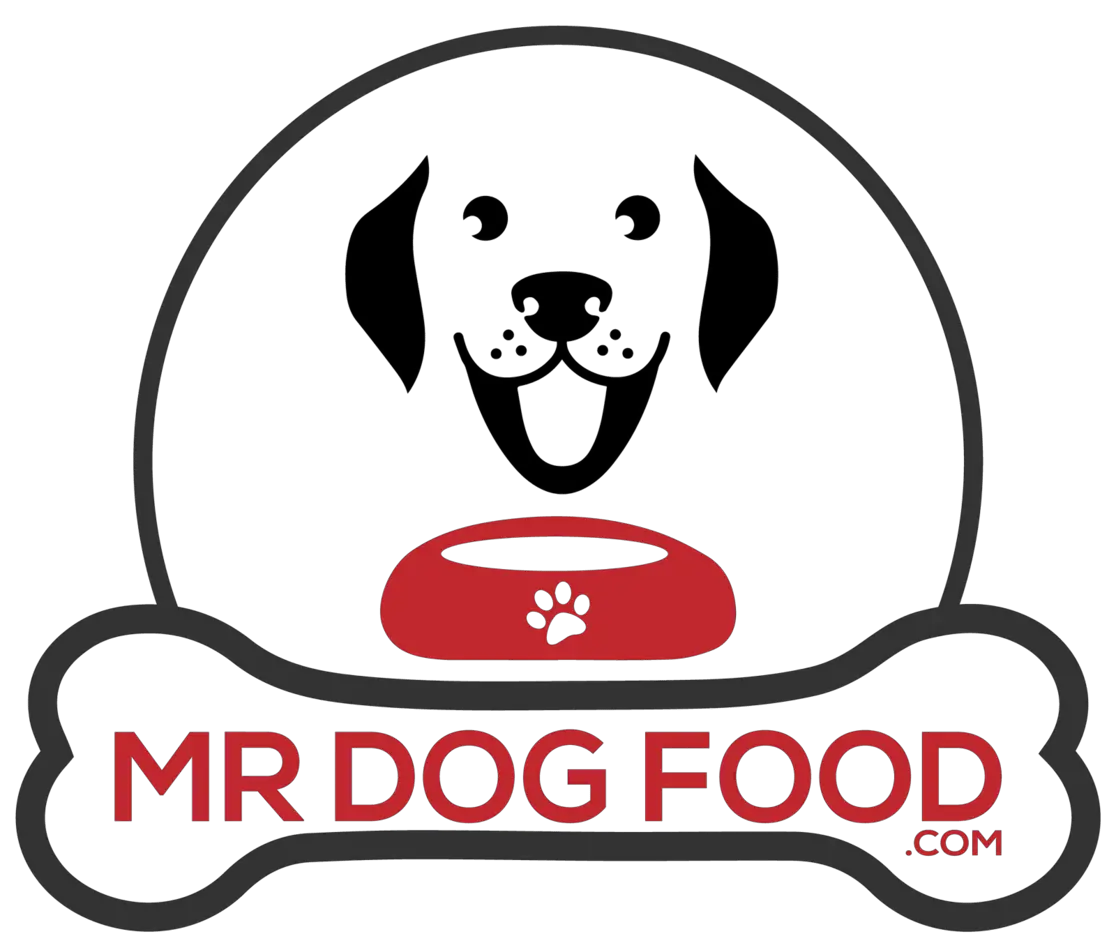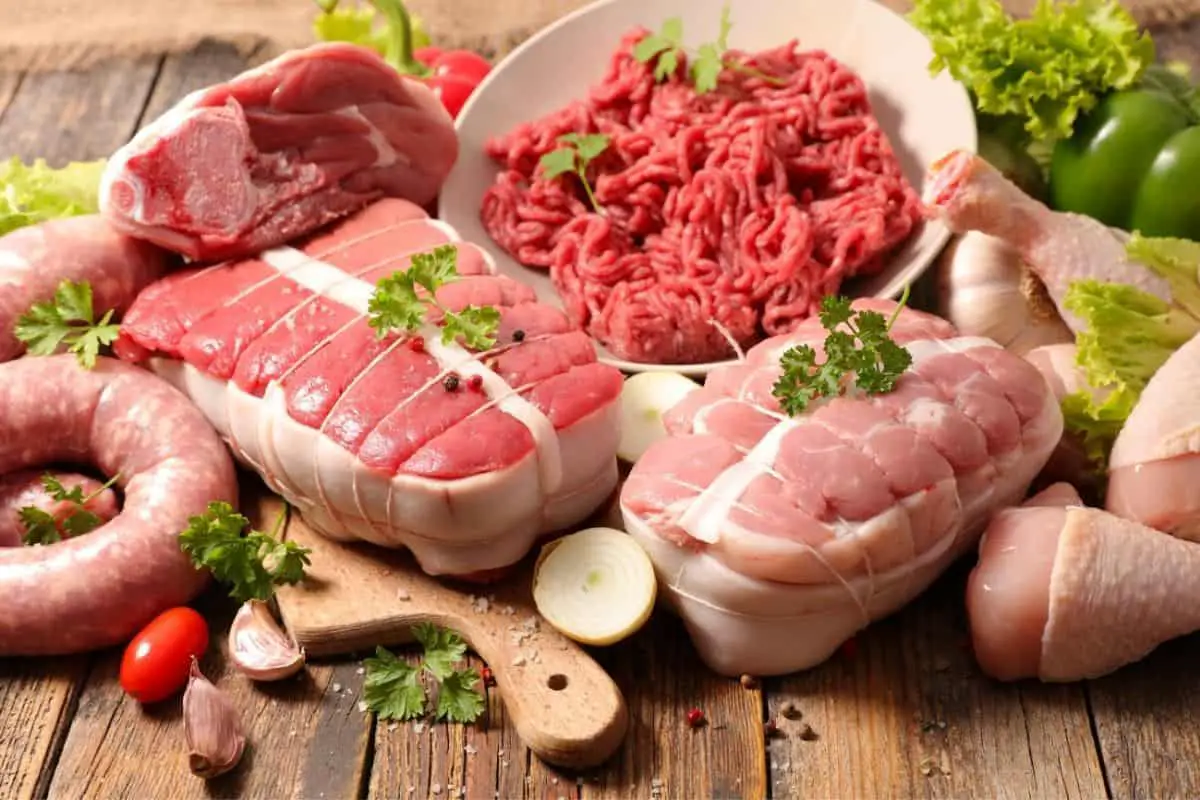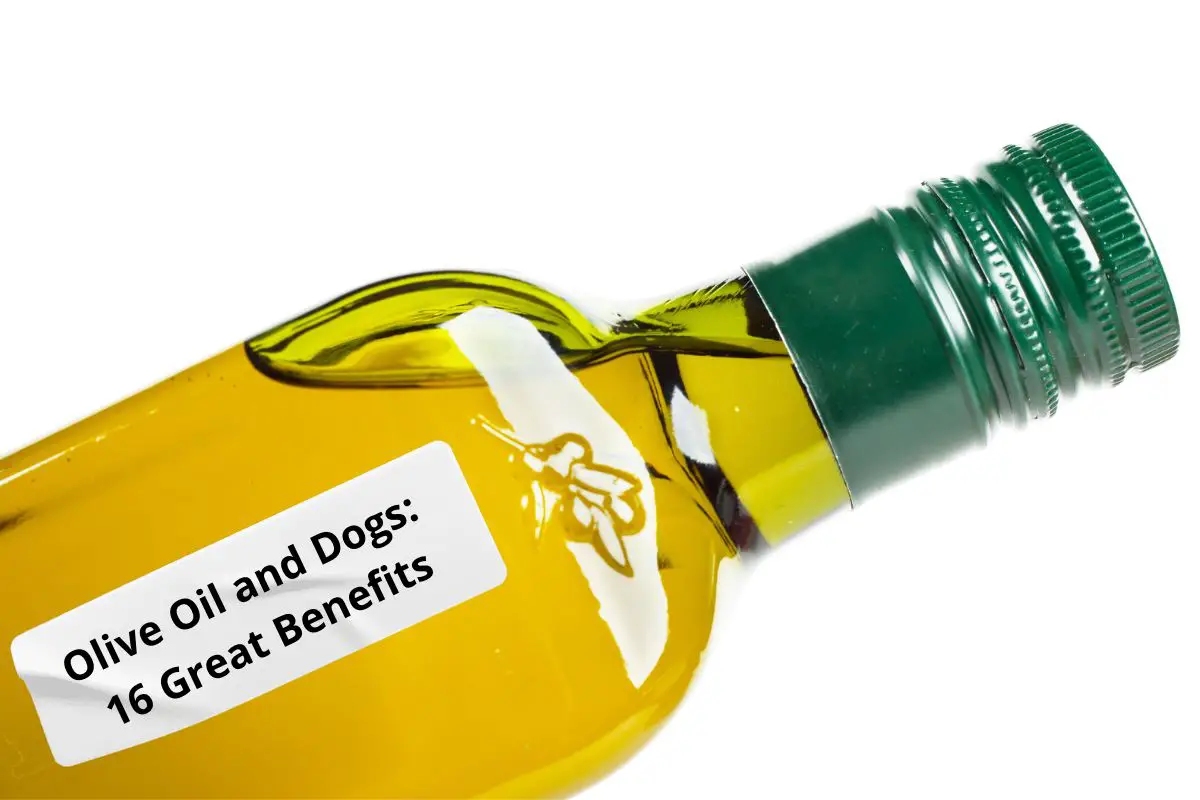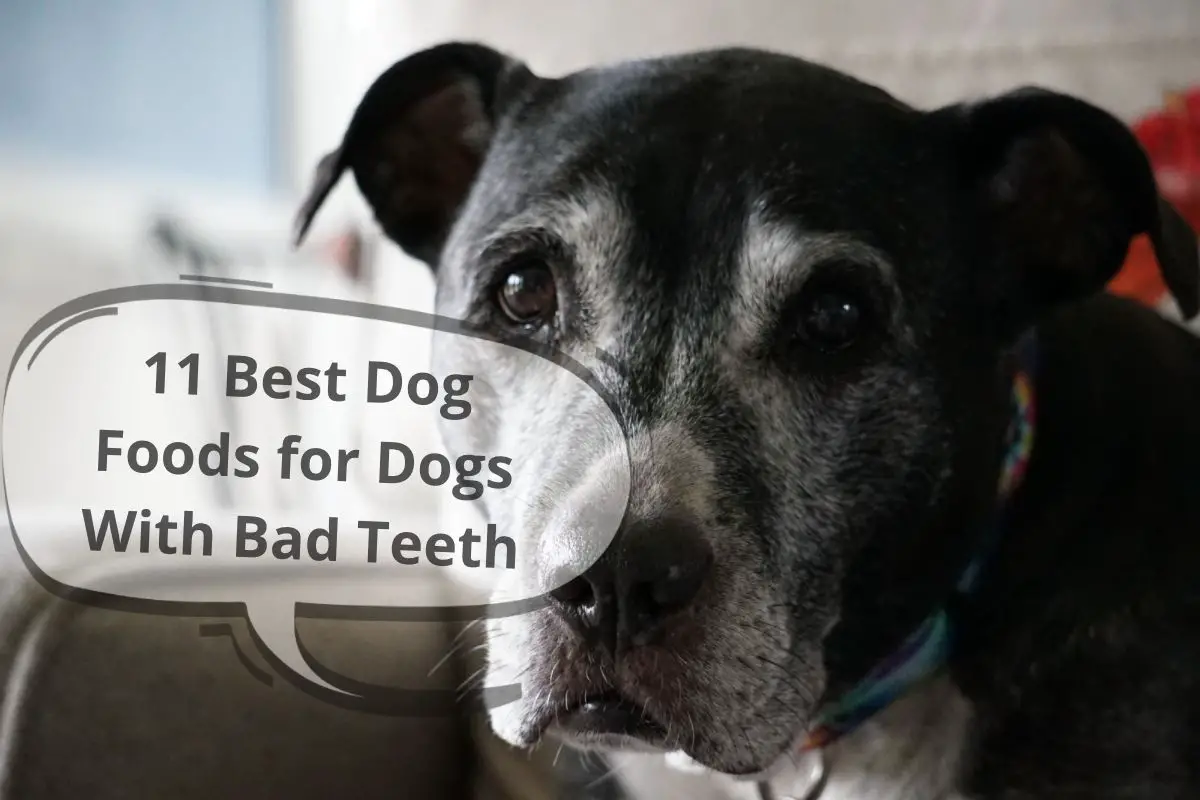This post contains affiliate links.
Of course, we all want the best for our dogs, but some of us are on a budget. Are you considering the transition from kibble to raw food for your dog? There is a lot to learn with this transition, like if you can feed them raw meat from your local grocery store.
You can feed your dog raw meat from the grocery store, as a dog’s diet consists of 70-80% muscle meat like chicken, lamb, or venison. Be sure to dedicate another 5% to animal kidneys, brains, and hearts. To achieve a well-balanced raw diet, dogs also need liver, vegetables, and raw edible bone.
If you have decided to switch your dog’s diet from kibble to raw, then you have made a decision that will improve their health and wellbeing for a long time. This article will cover everything you need to know about purchasing raw meat from the grocery store, as well as top-notch information about raw food diets for your dog.
Table of Contents
Is Grocery Store Meat Safe?
There is a relatively common fear around raw pet food, but the reality is that grocery store meat is safe, natural, and healthy for your pet. However, you might be specifically concerned with the quality of meat you purchase from there. Fortunately, grocery store meat is perfectly safe to feed your dog.
However, there is one caveat to exclusively shopping at the grocery store for your pet. Even though grocery store meat is safe for your dog to consume, it may be challenging to find all of the ingredients your dog needs for a balanced diet.
We’ll talk more about a balanced canine diet later!
But generally, grocery stores carry the basics: ground beef, ground turkey, and chicken. While these are all excellent choices for your dog, they should not be the only things on the menu. To expand their nutrients, you should purchase varying types of meat that aren’t on the grocery store shelves.
|
Pros |
Cons |
|
Raw meat is absent from chemicals |
There are some risks when feeding dogs raw meat |
|
Dogs’ digestive systems were designed for raw diets |
Raw food diets require a lot of knowledge |
|
Raw diets increase dogs’ lifespans |
It can be more expensive |
|
Your dog will be healthier overall |
It requires more storage space |
|
It is more time consuming |
Pros of Raw Meat
If you are considering transitioning to a raw diet for your pup, there are numerous ways it can benefit their health. From the inside (digestion) to the outside (skin and fur) and everything in between (teeth), your dog’s health and wellbeing will be at their best on a raw diet. Watch their bowel movements get smaller and smile get bigger as you eliminate overly processed “scientific” foods from their diet. Continue reading for all the reasons to consider switching today.
Raw Meat Is Fresh and Absent of Chemicals
If you are familiar with purchasing regular dog food, you know that many of the ingredients are hard to pronounce and that the first ingredient is often grains. However, with a raw diet, you know for certain that it’s 100% fresh and natural. Raw diets don’t have the same harsh chemicals and additives as kibble and canned food options, making them gentler on Fido’s body.
Dogs’ Digestive Systems Were Designed for Raw Diets
Raw diets are simply a return to a dog’s natural diet. Dogs struggle to digest grains, which are often a significant component of commercialized foods. Raw diets also offer easier digestion and more absorption of those critical nutrients. Better yet, easier digestion makes for smaller and less stinky stools.
Raw Diets Replicate What Dogs’ Ancestors Ate
Fortunately, since there is no need to hunt for meals, domesticated dogs face no starvation risk. You can rest assured that raw diets (yes, even meat from the grocery store) are safe and healthy for your dog. In fact, it is the best way to ensure a long and healthy life for your pup.
Raw Diets Increase Dogs’ Lifespans
Evidence suggests that dogs that are fed a raw diet live up to three years longer than their kibble-fed counterparts. Similarly, dogs that are fed raw meats, bones, and organs (as opposed to kibble) are less likely to develop cancer and other life-threatening diseases during their lifetime!
Your Dog Will Be Healthier Overall
Beyond a longer lifespan, dogs fed a raw diet show improvements in so many aspects of their lives. Back in the 1990s, Dr. Ian Billighurst gave his own dogs raw meat and bones (instead of their kibble) as an experiment and noticed immediate improvements in multiple facets of their lives. His research demonstrates that raw-fed dogs have shinier coats, fewer skin allergies, and cleaner teeth.
Cons of Raw Meat
Where there are pros, there are always a few cons to balance it out. When making decisions like this one, it is important to consider all of the facts. Even though there are numerous benefits to going raw, there are also some drawbacks to keep in mind. In the end, you may decide that going raw is not for you. Check out some of the cons below.
There Are Some Risks When Feeding Dogs Raw Meat
Handling raw meat can introduce dangerous bacteria into your home, making it especially concerning for families with young, curious children. Be sure to feed your dog outside or away from tiny, curious fingers.
Second, there is also a small risk that your dog’s stomach will not adjust well to a lifelong diet of kibble or cooked foods. Keep an eye out for unusual behaviors and make the complete transition to raw slowly, as it’s not an overnight change.
Raw Food Diets Require a Lot of Knowledge
It seems overwhelming at first, but you will get the hang of it. Pet owners researching raw diets are often bombarded with information, and it’s not always clear what’s accurate. Despite the abundance of information, there is a risk that pet owners don’t know much about the nutrients their pets need. Stay informed about how to get the right nutrients in your dog’s bowl.
If you decide to go raw, consider purchasing the book that started the raw diet frenzy in the early 1990s. Despite its age, it still includes tons of relevant and helpful information for pet owners who are transitioning to raw for the first time. Check out Dr. Billinghurst’s Give Your Dog a Bone for a jump start on the education part of the diet.
It Can Be More Expensive
While there are ways to feed raw on a budget, it is challenging and time-consuming. Many options are made even more costly with raw food subscription services and premade foods from the pet store. Even if you go the traditional route of purchasing and preparing all the food yourself, you are likely spending more money than if your pet was on a classic kibble diet.
It Requires More Storage Space
Particularly if you go the “meal prepping” route, you would have to store days and weeks’ worth of meals at a time. That is simply unacceptable to folks living in more urban environments where kitchens are small, and freezer space is a hot commodity.
It Is More Time-Consuming
Beyond having to learn all of the nutritional information initially, raw diets can be time-consuming in other ways. Daily, it requires more time and attention to make a raw bowl than a scoop of kibble, which you can easily pour. On a weekly or monthly basis, many pet owners spend hours cutting and preparing food for several days or weeks in advance.
What Should I Feed My Dog on a Raw Diet?
What you should feed your dog on a raw diet depends mainly on the raw diet model you follow, which is important to weigh. Two popular raw diet models are the Biologically Appropriate Raw Food (BARF) diet – initially introduced by Dr. Billingshurt – and the Prey Model Raw (PMR) diet.
The main difference between these two models is the addition of fruits, vegetables, nuts, and seeds to the BARF diet. Coined by Dr. Billinghurst, originally meaning “Bones and Raw Food Diet,” the BARF diet aims to incorporate all of the foods your dog can digest easily. These components will be discussed in the following section.
On the other hand, the PMR diet includes feathers and furs. As the acronym indicates, the Prey Model Raw diet is meant to mirror the diet your dog might have out in the wild – if they were not relying on humans to feed them. In this case, they would not be eating fruits, vegetables, or seeds. Rather, they would be consuming the entire animal – bones, feathers, and organs included – which is exactly what is included in this diet.
Let’s go over the essential components of a raw diet and suggest a few sources of these nutrients in the gaps raw grocery meats leave.
Muscle Meat
Muscle meat is the most significant component of the BARF and PMR raw food diets, making up between 70 and 80 percent. Dogs get critical nutrients from muscle meat, such as protein for strong bones, vitamins, and amino acids. A few muscle meat examples include animal tongues, gizzards, cartilage, tendons, chicken, lamb, or venison.
Raw Edible Bone
You may have heard that you shouldn’t let your dog have bones because they will splinter in their digestive system and potentially puncture an organ. However, not only are they safe, but they are also an essential component of the BARF and PMR diets. Your dog should be consuming about 10 percent of their calories from soft raw bones in both diets, such as animal feet, tails, and wings.
Vegetables (BARF Only)
It may be surprising to see vegetables as part of an essential balanced diet for your pup. However, they are a vital source of vitamins and minerals. They only need their diet to consist of about 7 percent vegetables in the BARF diet, and they are not included in the PMR diet at all. If you follow the BARF diet, you can feed your dog almost any vegetable, including peas, carrots, beets, or broccoli.
Liver
With both the PMR and BARF diets, about 5 percent of your dog’s meals should be liver. More so than other organs, livers provide the essential nutrient vitamin A and other water-soluble vitamins. If your dog is sensitive to vitamin A, you can feed them as little as two percent liver to accommodate that sensitivity. Don’t worry; they will still get enough vitamin A to be healthy.
Other Organs
Whether you are following the BARF or the PMR diet, approximately 5 percent of your pup’s bowl should be various organs. While they are not pleasant to look at, organs provide a plethora of nutrients for a well-balanced diet. Kidneys, brains, hearts, and spleens are all excellent choices for mealtime.
Seeds and Nuts (BARF Only)
If you are following the BARF diet, you should include a few seeds and nuts for meals. Even though it makes up a small percentage (2 percent), they still provide essential minerals, fatty acids, and other nutrients that keep your pup happy and healthy. However, it is important to keep in mind that dogs cannot digest whole seeds and nuts, so seeds mixed into chicken chunks aren’t an option!
They should be soaked in water and ground to support digestion. Also, don’t feed Fido pits or seeds from fruits such as avocados, plums, or apples.
Fruit (BARF Only)
Fruits are also a critical component of a dog’s diet. Like for humans, they provide crucial disease-preventing antioxidants. However, don’t allow fruits to make up more than 1 percent of your dog’s diet due to their high sugar contents. Small amounts of natural sugars are okay, but dogs are not meant to digest large amounts of natural or artificial sugars. Add some apples, watermelon, or berries to your dog’s meal for a little extra flavor!
Animal Based Insoluble Fiber (PMR Only)
Since the PMR diet doesn’t include fruits, vegetables, nuts, or seeds, dogs have to get those nutrients from somewhere else. In this model, they get fiber and other vital nutrients from the fur and feathers from their “prey.” Pet owners feed their dogs all parts of the animal, including those left out of the BARF diet.
Food to Avoid on the Raw Food Diet
As you transition your dog kibble to a raw diet, there are some mistakes you’ll want to avoid making. For example, some fruits and bones can be toxic or hazardous to your canine companion, so be sure to do your research.
Here are the foods to 100% avoid:
- Grapes: Grapes (and raisins) are extremely toxic to dogs and can cause an immediate reaction when ingested. While experts do not know precisely what is in grapes that are poisonous to dogs, they know that they can result in severe symptoms, such as loss of appetite, vomiting, lethargy, and even death.
- Big bones: While small, soft bones (like feet and neck bones) are essential components of a raw diet, more significant, weight-bearing bones can cause broken teeth or worse. Avoid giving your dog large bones unless you are positive that they will only chew on them. Attempts to eat the bones can result in punctured organs or broken teeth.
- Cooked bones: It is extremely important to remember that all forms of cooked bones (boiled, dehydrated, etc.) are dangerous for your pet to consume. You should also avoid feeding your dog turkey drumsticks, beef bones, and weight-bearing bones like the legs.
- Ground meat: Yes, ground meat is perfectly safe for your dog to eat. However, one mistake you should avoid is only feeding them ground meat. Different meats have different levels of protein, fat, and other nutrients, as you might already know. This is why it is important to diversify your dog’s menu. Include choices you might not see at the grocery store, such as lamb, oysters, or bison.
Alternatives to Buying Grocery Store Meat
We also reviewed a few alternative ideas for pet owners who are still hesitant about purchasing raw meat from the grocery store. These ideas are also great for folks who want to expand their pet food options beyond what the grocery store offers in terms of bones, organs, and types of meat.
Continue reading for some excellent alternatives to grocery store meat.
Consider a Subscription Box (i.e., Cali Raw)
You can get subscriptions for anything these days – wine, make-up, clothes, and yes, even raw dog food. With raw diets rising in popularity, there are now several subscription options to choose from. While slightly more expensive, subscription boxes offer an undeniable convenience for pet owners, especially those new to raw foods.
For example, Cali Raw delivers your dog’s meals to your door each month. This company makes raw diets seamless by calculating the balance of nutrients for a perfect dog food formula and arranging automatic renewals each month. Furthermore, their packaging is eco-friendly, and they guarantee a healthier pup in 30 days.
Try Premade Raw Meals
You may have glossed over these last time you were at the grocery store or pet store, but many larger companies sell premade raw dog foods. These are more affordable than the subscription boxes but offer similar convenience. They are pre-balanced to include all of the nutrients your pup needs. All you have to do is calculate how much your dog needs by their weight!
While this is a convenient option for pet owners, there is one significant drawback. This option might include some of the chemical additives that you are trying to avoid, all in the name of making it last longer. Preservation efforts often directly conflict with our efforts to avoid feeding our dogs (and ourselves) unnecessary chemical additives.
Check Out New Grocery Stores
If you are not in the habit of shopping at your local grocery store, we highly recommend it. Beyond finding excellent snacks and cooking ingredients, you will likely find a lot of seafood, meats, bones, and organs that are less popular at more prominent grocery store outlets. Many of these ingredients have a nutritious value for your dog that you cannot find in the chicken breast or ground meat in your usual store.
Seek Out Your Local Butcher Shops
If your community has a butcher shop, we highly recommend checking it out. You’ll have access to more parts of the animal, expanded organ options, and other animal products such as fats, skins, and feet. These animal products have enormous nutrient value and are typically not found at your more prominent grocery store outlets such as Kroger or Publix. Furthermore, many butcher stores are willing to sell their scraps for a cheaper rate, saving you hard-earned money.
Conclusion
Hopefully, if you were hesitant about purchasing grocery store meat for your dog’s raw diet, this article brought you some clarity. Grocery store meat is just as healthy and safe as meat you would purchase elsewhere, and it’s far healthier than classic dog food.
However, there are a couple of important things to keep in mind if you decide to go this route. Remember to diversify your pup’s dinner menu with items from other grocery stores or butcher shops. Avoid giving them large, weight-bearing bones (especially without supervision), cooked bones, and toxic fruits.
Sources
- The Farmer’s Dog: History of Commercial Pet Food
- Whole Dog Journal: The Evolution of the Raw Dog Food Diet
- Honey’s Real Dog Food: Why Raw?
- American Kennel Club: Fresh vs. Raw Dog Food vs. Kibble: Which Diet is Best for Your Dog?
- Pets WebMD: Raw Dog Food Diet: Benefits and Risks
- Relation Between Domestic Dog’s Wellbeing and Life Expectancy
- Perfectly Rawsome: Prey Model Raw Diet for Adult Dogs
- Perfectly Rawsome: Biologically Appropriate Raw Diet for Adult Dogs
- American Kennel Club: Can Dogs Eat Grapes?
- Keep the Tail Wagging: 5 Raw Feeding Mistakes Dog Owners Make
- Dogs Naturally Magazine: Hopes and Hazards of Feeding Your Dog Raw Meat
Mrdogfood.com is a participant in the Amazon Services LLC Associates Program, an affiliate advertising program designed to provide a means for sites to earn advertising fees by advertising and linking to Amazon.com. We also participate in other affiliate programs which compensate us for referring traffic.




